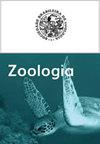Breeding behavior of the Helmeted Manakin Antilophia galeata (Passeriformes: Pipridae) in a gallery forest from São Paulo state, Brazil
IF 1.8
4区 生物学
Q4 ZOOLOGY
引用次数: 0
Abstract
. Information on the breeding biology of most Neotropical birds, and interpopulation comparisons, are insufficient. The Helmeted Manakin, Antilophia galeata (Lichtenstein, 1823), is a forest understory passerine commonly found in the gallery forests of the tropical savanna-like Cerrado biome. We provide information about the nesting phenology, nesting cycle, nests, eggs, nestlings, and nest-site characteristics of a population of the Helmeted Manakin in the state of São Paulo, southeastern Brazil. During two breeding seasons we found 16 active, and 30 inactive nests. Breeding activities occurred from mid-August to mid-January, and nests were constructed in bushes and saplings in the forest’s understory, 0.45–3.48 m above ground (1.56 ± 0.66 m). Clutch size was two eggs, which were laid in intervals of one to three days. Three remarkable patterns of interclutch egg color and marking variations were observed. The incubation period of two nests was 18 and 19 days, and nestling periods were 16.3 ± 0.6 days (16–17 days, n = 3 nests). The apparent nest survival of 11 thoroughly monitored nests was 36.4%. In addition to the first description of the interclutch egg pattern variations, the following information differs from previous literature data: egg laying interval and nestling periods. Our data contribute to the overall knowledge of the variations in breeding parameters of the Helmeted Manakin.巴西圣保罗州廊道林中盔蝠的繁殖行为
。关于大多数新热带鸟类的繁殖生物学和种群间比较的信息是不足的。盔Manakin, Antilophia galeata (Lichtenstein, 1823),是一种森林林下的雀形目动物,常见于热带稀树草原状的Cerrado生物群系的廊林中。本文研究了巴西东南部圣保罗州一种盔雉种群的筑巢物候、筑巢周期、巢、蛋、雏鸟和巢址特征。在两个繁殖季节,我们发现了16个活跃的巢穴和30个不活跃的巢穴。繁殖时间为8月中旬至1月中旬,在林下灌木和幼树中筑巢,巢距地面0.45 ~ 3.48 m(1.56±0.66 m),每窝2枚,每隔1 ~ 3天产卵一次。观察到卵间颜色和标记变化的三种显著模式。2窝孵育期分别为18和19 d,雏鸟孵化期为16.3±0.6 d (16 ~ 17 d, n = 3窝)。11个彻底监测的巢的表观成活率为36.4%。除了第一次描述孵蛋间模式的变化外,以下信息与先前的文献数据不同:产卵间隔和雏鸟时期。我们的数据有助于全面了解戴头盔的马纳金的育种参数的变化。
本文章由计算机程序翻译,如有差异,请以英文原文为准。
求助全文
约1分钟内获得全文
求助全文
来源期刊

Zoologia
生物-动物学
自引率
0.00%
发文量
15
期刊介绍:
Zoologia, the scientific journal of the Sociedade Brasileira de Zoologia (SBZ), is an international peer-reviewed, open-access Zoological journal that publishes original research on systematics, evolution, taxonomy, nomenclature, biogeography, morphology, physiology, biology, ecology, symbiosis, conservation, behavior, genetics and allied fields. The journal, formerly known as Revista Brasileira de Zoologia, publishes original articles authored by both members and non-members of the Society. The manuscripts should be written exclusively in English.
 求助内容:
求助内容: 应助结果提醒方式:
应助结果提醒方式:


